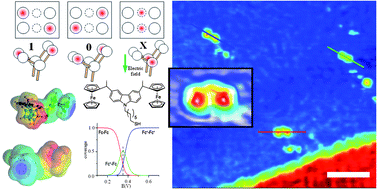Toward quantum-dot cellular automata units: thiolated-carbazole linked bisferrocenes†
Abstract
Quantum-dot Cellular Automata (QCA) exploit quantum confinement, tunneling and electrostatic interaction for transistorless digital computing. Implementation at the molecular scale requires carefully tailored units which must obey several structural and functional constraints, ranging from the capability to confine charge efficiently on different ‘quantum-dot centers’—in order to sharply encode the Boolean states—up to the possibility of having their state blanked out upon application of an external signal. In addition, the molecular units must preserve their geometry in the solid state, to interact electrostatically in a controlled way. Here, we present a novel class of organometallic molecules, 6-3,6-bis(1-ethylferrocen)-9H-carbazol-9-yl-6-hexan-1-thiols, which are engineered to satisfy all such crucial requirements at once, as confirmed by electrochemistry and scanning tunneling


 Please wait while we load your content...
Please wait while we load your content...